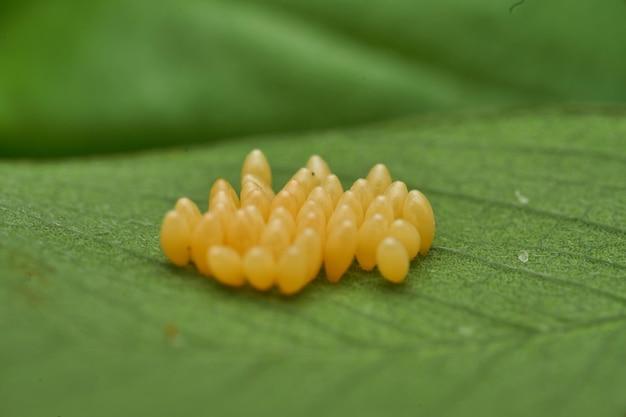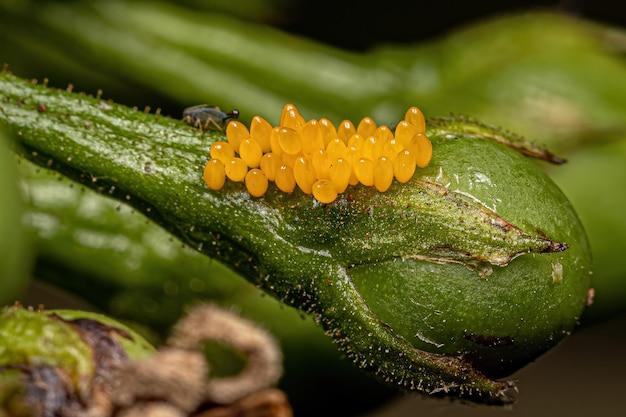Welcome to our blog post all about ladybug eggs and the intriguing world of these charming beetles. Have you ever wondered what ladybug eggs look like or where ladybugs lay their eggs? Look no further! In this post, we will delve into the world of ladybug reproduction, covering everything from the appearance of their eggs to the remarkable transformation of their larvae into the adorable little bugs we all know and love.
Ladybugs, scientifically known as Coccinellidae, are a family of small beetles that are widely known and recognized for their vibrant colors and distinctive spots. These tiny creatures are not only a delight to behold but also play a crucial role in maintaining ecological balance by feeding on harmful pests, such as aphids. With their beneficial qualities and charming appearance, it’s no wonder why many people are fascinated by these tiny beetles and are curious to learn more about them.
So, let’s begin our journey into the captivating realm of ladybugs, starting with the exquisite eggs they lay and how you can identify them. Along the way, we’ll also address some commonly asked questions regarding ladybug behavior and characteristics. From their nesting habits to the lifecycle of ladybugs, we’ll reveal the secrets of these enchanting creatures and deepen our appreciation for their remarkable existence. So, grab a cup of tea and get ready to embark on an enthralling adventure into the world of ladybugs!

How Do Ladybug Eggs Look Like
Ladybugs, those charming little creatures that brighten up our gardens with their vibrant colors, begin their fascinating life cycle as – you guessed it – eggs! But what do these ladybug eggs actually look like? Prepare to be amazed as we take a closer look at these tiny, yet utterly adorable, ovals of potential ladybug greatness.
The Delicate Art of Ladybug Egg Discovery
Before we dive into the intricate details of ladybug eggs, let’s take a moment to appreciate the art of egg discovery. Picture this: you’re strolling through your garden, minding your own business, when suddenly your eyes catch a glimpse of something peculiar. It’s small, it’s eye-catching, it’s… a ladybug egg!
A Masterpiece in Miniature
Ladybug eggs are like nature’s tiny masterpieces. These miniature ovals range in size from a mere pinhead to a dainty sesame seed. Their coloration, oh so exquisite, can vary depending on the species. You might encounter eggs that glisten in a pale yellow hue, while others boast a stunningly bright orange or even a striking white. Talk about fashion-forward eggs!
A Closer Look at Ladybug Egg Evolution
Now, let’s dive into the fascinating journey of ladybug egg evolution. A freshly laid ladybug egg starts off as a charmingly round shape, almost resembling a miniature pearl. But as the days pass, a miracle takes place – the egg magically matures, morphing into a distinctive elongated oval with slight ridges. It’s like Ladybug Egg Glow-Up 101!
A Gentle Touch of Adhesive Magic
But what keeps these precious eggs firmly in place, you may wonder? Well, within the delicate ridges of these tiny ovals lies a secret trick – a touch of adhesive magic! Ladybugs have evolved to secrete a special substance from their bodies, allowing them to attach their eggs to leaves, stems, or other surfaces. It’s like Mother Nature’s very own egg superglue!
The Joyful Mystery of Ladybug Hatchlings
Ladybug eggs may be cute and alluring, but what happens next is the true delight: they hatch! Voila! Out comes the tiny, wriggling ladybug larvae, ready to embark on their journey to adulthood. These larvae resemble tiny alien creatures, with their elongated bodies and peculiar spiky protrusions. They may not win any beauty pageants, but they sure have a charisma of their own.
Unlocking the Magic of Ladybug Eggs
Ladybug eggs, though often overlooked, are an enchanting glimpse into the miraculous world of these beloved beetles. From their miniature size and captivating colors to their marvelously adhesive nature, these tiny oval wonders hold the key to the ladybug life cycle. So, next time you stumble upon a ladybug egg, take a moment to marvel at the incredible journey unfolding before your very eyes.
Ladybug eggs: proof that even in the smallest of packages, nature’s true marvels await!
Note: The information provided above is accurate as of the year 2023.

FAQ: How do ladybug eggs look like
If you’ve ever come across a ladybug, you must have noticed how captivating and beautiful they are. These little predators not only bring luck but also serve as natural pest control in gardens. But have you ever wondered what ladybug eggs look like? Or how to take care of them? Or even if it’s okay to have ladybugs in your house? In this FAQ-style guide, we’ll answer all your burning questions about ladybug eggs and more!
How do you take care of ladybug eggs
Taking care of ladybug eggs can be a rewarding experience. Here’s what you need to know:
-
Create a suitable habitat: Ladybugs lay their eggs near aphid colonies. Release the ladybugs in your garden or provide them with plants that attract aphids for them to lay eggs on.
-
Avoid using pesticides: Pesticides harm ladybugs and their eggs. Opt for organic pest control methods instead.
-
Provide a food source: Ladybug larvae and adults love to feast on aphids. Ensure you have plenty of aphids available for them to devour.
Is it okay to have ladybugs in your house
Ladybugs are harmless and can actually be quite beneficial in your home. Here’s why:
-
Natural pest control: Ladybugs feed on pests such as aphids, mites, and scale insects, ensuring your plants stay healthy.
-
Good luck: In many cultures, ladybugs are believed to bring luck and prosperity. So having them in your house might just be a positive omen!
What do ladybug larvae look like
Ladybug larvae may not resemble their cute adult selves, but they have their own unique charm. Here are some characteristics:
-
Spiky appearance: Ladybug larvae have a spiky and elongated body, often with dark-colored spikes or bumps.
-
Colorful: Ladybug larvae can come in various colors, including black, orange, yellow, or red with spots.
-
Crawler-like movement: Unlike their adult counterparts, ladybug larvae have a distinctive crawling movement.
Where do ladybugs nest
Ladybugs are resourceful when it comes to finding the perfect nesting spot. Here are some common places you might find ladybug nests:
-
Gardens: Ladybugs often lay their eggs near aphid-infested plants, providing their larvae with an immediate food source.
-
Grassy areas: Ladybugs may also lay eggs in habitats with tall grasses or weeds, offering protection and shelter.
-
Undisturbed areas: Ladybugs prefer quiet and undisturbed locations for nesting, such as leaf litter or tree bark crevices.
Do ladybugs multiply
Yes, ladybugs do multiply! They reproduce at a rapid pace, especially when their preferred food source, aphids, is abundant. A single ladybug can lay hundreds of eggs in her lifetime, so it’s not uncommon to find a bustling population in your garden.
What insect lays tiny gold eggs
While ladybugs are often associated with their red-and-black bodies, their eggs are not gold. You might be thinking of a different insect, such as lacewings or certain species of beetles, which lay small golden eggs.
Do ladybugs eat their babies
Contrary to popular belief, ladybugs do not eat their own babies. Ladybugs are protective parents, and the mother will lay her eggs near a food source to ensure her young have enough to eat when they hatch.
What do ladybug babies look like
Ladybug babies, also known as larvae, go through a fascinating transformation. Here’s what they look like:
-
Tiny and elongated: Baby ladybugs have a small, narrow body shape.
-
Spotted appearance: Like their adult counterparts, ladybug larvae have distinctive spots on their bodies.
-
Crawler-like movement: Baby ladybugs move with a distinctive crawling motion, often resembling tiny, bustling caterpillars.
Where do ladybugs lay eggs
Ladybugs prefer to lay their eggs in locations abundant with aphids, their favorite food. Common spots include:
-
Undersides of leaves: Ladybugs often choose the undersides of leaves to protect their eggs from predators.
-
Plant stems: Some ladybug species lay their eggs directly on plant stems, where the hatched larvae can immediately feed on nearby aphids.
Can you keep a ladybug as a pet
Keeping a ladybug as a pet can be a fun and educational experience. However, it’s important to note that ladybugs have specific habitat and dietary needs. Here’s what you should keep in mind:
-
Release them after a few days: Ladybugs are best enjoyed as temporary guests. Provide them with food and shelter before releasing them back into the wild.
-
Create a suitable environment: Set up a small container with plenty of plant material and a source of water for your ladybug pet.
What month do ladybugs come out
Ladybugs typically come out in the early spring or summer months when temperatures start to rise. They become more active as the weather gets warmer, searching for food and mates.
How many days does it take for ladybug eggs to hatch
The exact time for ladybug eggs to hatch depends on various factors, including temperature and species. On average, it takes about 3 to 5 days for ladybug eggs to hatch into larvae.
What do the larvae look like when they hatch from the eggs
When ladybug larvae first hatch from their eggs, they look like tiny, elongated creatures with a spiky appearance. They are already on the lookout for their favorite meal – aphids!
How do you tell if a ladybug is a boy or a girl
Determining the sex of a ladybug can be quite challenging without the help of a microscope. However, male ladybugs tend to be smaller and have more vibrant colors than females.